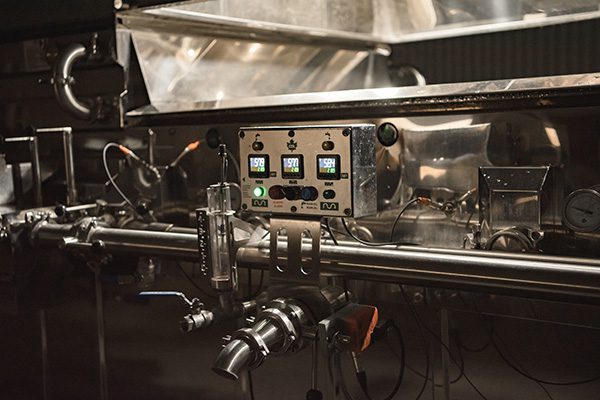Like anything worth doing well, a lot goes into maple syrup production. We take pride in running a facility that uses modern methods and state-of-the-art machines to produce a traditional, high-quality, USDA organic product.
Let’s look at some of our equipment and the production process here at Meridan Hill, and find out what happens after the tap.
Sap right out of the sugar maple is about 98% water. To turn sap into syrup, we need to reduce the amount of water and condense the sugars in it. Too much water in the syrup leads to a runny product that spoils quickly. Not enough water, and you start to get crystallization of the sugars. We use multiple steps to achieve the perfect balance through a process that produces a robustly flavorful syrup, while also maximizing production efficiency and saving energy. While we are a solar-powered farm, we look for any opportunity to conserve energy use. We’re forward-thinking like that!

Step 1: Reverse Osmosis
RO for short, reverse osmosis uses high pressure to separate the water from sugar in sap. We use an RO machine with a positive recirculation system that removes about 75-90% of the water, concentrating the sugar without high temperatures. This first step really cuts down on the time needed in step 2, the evaporator, reducing energy demands and increasing efficiency.

Step 2: Evaporation Station
After the RO machine, the condensed sap goes into the evaporator to be boiled. If you’ve ever seen pictures of old timers in a sugar shack feeding logs into a woodstove with a cast iron pot of liquid on top, this is what they were doing! We’ve replaced the stove and pot with a shiny but rugged Master evaporator. It gives us stable temperatures and more precise controls, which allow us to produce consistently excellent flavor. Another benefit to our evaporator over the pot? Its stainless-steel construction makes it easy for us to maintain our high purity standards.

Step 3: Maillard Magic
At this point in production, we’re nearing optimal sugar content. But it isn’t just the reduction in water content that turns sap into syrup. There is an additional chemical change involved — think toasted marshmallows, the golden crust of baked goods, and even seared steak — the Maillard reaction. This is where the maple syrup magic happens. The amino acids and sugars react at high temperature to produce the rich flavor and deep color of a superior maple syrup. This is why the boil is essential to production.
The sap is now syrup, or “liquid gold,” as many New Englanders call it. We have reached the optimal sugar concentration, a Goldilocks balance — or, depending on the grade, Golden Delicate, Rich Amber, or Dark Robust — that’s just right. We’ve taken over 30% of the water content out of the sap through RO and evaporation, and produced the highest quality natural, organic product.
We’re proud of our maple syrup, proud of the care we take with our process, and proud to honor our values with the work we do every day. If you love maple syrup, we know you’ll enjoy the end result!
